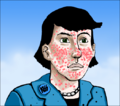 Acne vulgaris has anecdotally been attributed to diet.
Acne vulgaris has anecdotally been attributed to diet.
This review by researchers at The George Washington University Medical Center, in Washington, DC, found convincing data supporting the role of dairy products and high-glycemic-index foods.
First, the details.
- 21 observational studies and 6 clinical studies of acne and diet were evaluated.
And, the results.
- Dietary preferences
- People who migrate and change to western diets experience an increased risk of acne.
- Cow’s milk
- 2 large, controlled prospective studies reported that cow’s milk increased acne prevalence and severity.
- In 1 study, those with the highest total milk intake (greater than 3 servings per day) reported more frequent acne vs the lowest intake (0 to 1 serving per week).
- This association was strongest (a 44% increase) for skim milk intake, suggesting fat content was not the determining factor for acne risk.
- It’s not the fat, but perhaps hormones in milk affect acne risk.
- 2 large, controlled prospective studies reported that cow’s milk increased acne prevalence and severity.
- Glycemic-index: How fast a food raises blood sugar
- Well-designed prospective studies demonstrate a positive association between a high-glycemic-load diet, hormonal mediators, and acne risk.
- Increases in sex hormone-binding globulin (used to evaluate androgens) levels correlate with fewer acne lesions.
- Other dietary factors
- No study has established a positive association between acne and chocolate, saturated fat, or salt intake.
The bottom line?
Today, the most convincing dietary evidence for an effect on acne is with milk and high-glycemic-load.
6/15/10 20:17 JR